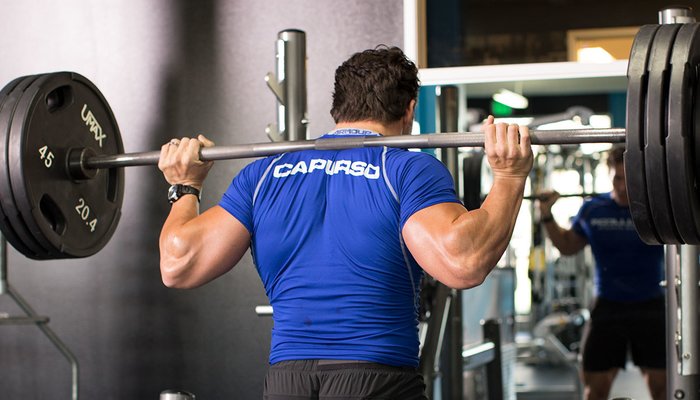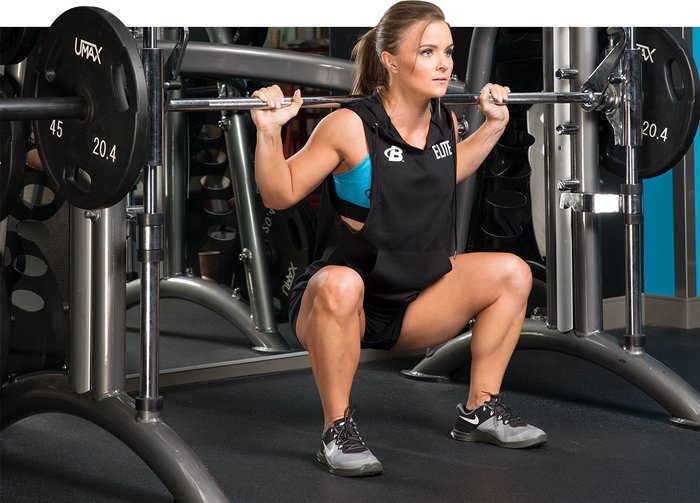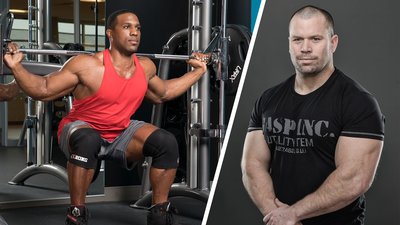Question: My goal is to become as strong as possible. A big bodybuilder at the gym said I should squat the weight up slowly to feel the muscles work. Should I do this?
Hell no! A more explosive squat is a stronger squat.
Try this experiment: Walk over to the dumbbell rack and slowly lift a 30-pound dumbbell, then set it down. Now, this time, snatch the dumbbell quickly off the rack. Does lifting it faster make it feel lighter? It should. The dumbbell should feel lighter, and there will be less time under tension.
When you squat heavy, have your intention be to lift the weight as fast as possible on the concentric portion of the rep with perfect technique. Besides being more likely to complete the rep, having this intention will help you gain many explosive strength adaptations. Even when lifting lighter weights, you can get maximal strength adaptations because your muscles and nervous system know the force you can produce—whatever weight is on the bar.
Even if you're squatting for bodybuilding purposes instead of to build strength, you'll still benefit from this technique. The greater amounts of force you produce training this way causes more muscle tension and recruits more fast-twitch muscle fibers, which have the most potential for growth.
When it's time to lower the weight back to the ground, your descent speed may vary—but it should be consistent. Commit to the descent and keep the speed the same across your sets and reps to build a repeatable movement pattern.

Let's look at four more common squat mistakes and what we can do to fix them.
You're Walking Around Too Much
"Waltz Across Texas" is a classic country-and-western song, but it sure as hell is something you want to avoid when you're doing a squat. Instead of taking multiple steps, the safest and most effective way to squat is to limit your walkout to no more than three steps:
- Step 1 gets you out of the rack.
- Step 2 sets your first foot.
- Step 3 places the opposite foot in the squat position.
Some advanced lifters do it in two: Step back with one foot, then do the same thing with the other. Whatever works for you—just keep your steps to a minimum.
Uneven Squat Bar Placement
I've hosted seminars from Okinawa to Oklahoma. No matter where I go, I always see people—even advanced lifters—place the bar in an asymmetrical position. They may be trying to rush through their workout or just not paying attention. It's also just hard to get the bar centered perfectly behind you. Whatever the cause, the results are the same. Putting more of the bar to the right or left of center makes one side of your body take more of the load, which can lead you to think you can't lift as much—and can cause your body to rotate unsafely.
Every time you first grip the barbell, focus on what you're doing and use reference points on the bar to make sure it is correctly positioned. If you have a training partner, he or she can help you adjust the position as needed. Get yourself lined up right, and you'll lift your max loads.
Proper Squat Depth
With strength as your primary objective, it's a fair bet to say that one day you may compete in powerlifting. Here's one big thing to keep in mind: Half squats produce half-assed results, so make it a habit to squat down to just slightly below parallel with every set and every rep you do. Hit the same spot every single time, and you'll build the skill of building strength through repetition.

Even if you never compete, doing squats to the proper depth will help you set realistic personal records and gauge yourself against other lifters.
Don't Look Up!
Some self-proclaimed Instagram "experts" suggest that looking up while you squat is safer for your spine. Not true! Looking up curves your cervical spine, which can lead to an increased chance of disc injury.
The best approach for safety and lifting the most weight is to keep your eyes straight ahead, which helps you maintain a neutral spine.
What's Next?
Check out some of Josh's other tips to proper squatting. And if you want to really get into the squatting life, look no further than Cory Gregory's Squat Every Day program!

